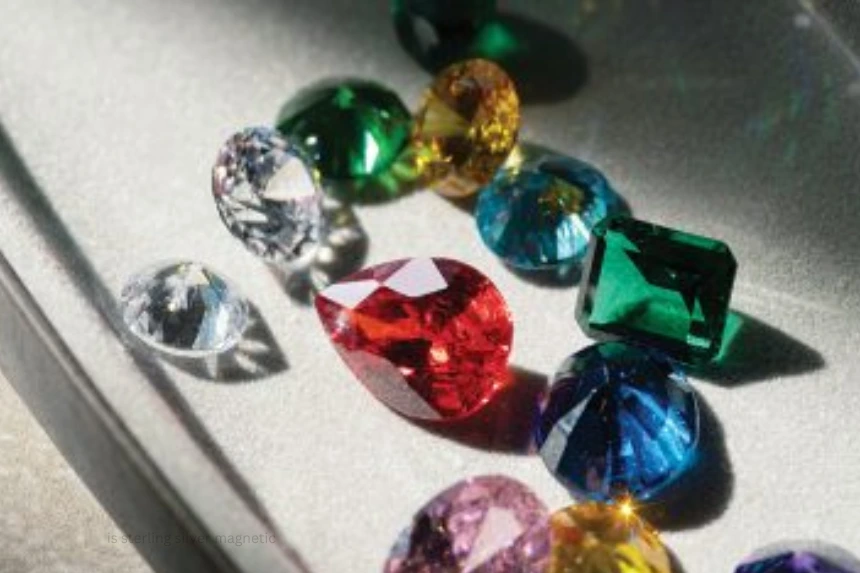Introduction: Addressing the Common Question About Sterling Silver
Many people interested in jewelry or silverware ask whether “is sterling silver magnetic?” It’s a common question, especially for those wanting to verify the authenticity of silver items. Understanding the magnetic properties of sterling silver can help you determine genuine pieces from counterfeit. This article will examine the facts regarding magnetism and sterling silver, supported by empirical evidence and useful testing advice.
What Is Sterling Silver? Composition and Uses
Sterling silver is composed of about 92.5% pure silver and 7.5% copper. This combination improves the hardness and durability of silver, which is naturally soft and prone to scratching. Sterling silver is frequently used for jewelry, cutlery, and decorative items because of its composition. A common indicator that a piece of jewelry is sterling silver is the “925” stamp.
Magnetic Properties of Metals: Basic Science
To understand whether sterling silver is magnetic, it’s helpful to know some basics about metal magnetism:
Diamagnetic materials (e.g., silver, copper) are repelled by magnetic fields — meaning they don’t stick.
Paramagnetic materials are weakly attracted but usually not noticeable without specialized equipment.
Ferromagnetic materials (e.g., iron, nickel, steel) are strongly attracted to magnets.
Most pure metals used in jewelry are diamagnetic or weakly paramagnetic, meaning they typically don’t respond to magnets.
Is Sterling Silver Magnetic? The Scientific Answer
Most sterling silver is not magnetic. Silver and copper, the two main components of sterling silver, are both diamagnetic. That means they do not have unpaired electrons that cause magnetic attraction, and under normal circumstances, they won’t stick to a magnet.
According to materials science data, pure silver (Ag) has a magnetic susceptibility of −9.1×10^−6, which indicates diamagnetism. Copper, which makes up about 7.5% of sterling silver, also exhibits diamagnetic qualities.
Why Do Some People Think Sterling Silver Is Magnetic?
Despite the facts, some believe that magnetic testing can verify silver authenticity. Common misconceptions include:
Fake silver contains magnetic metals like iron or steel, making it attract magnets.
Some low-quality or plated jewelry might seem magnetic due to base metals underneath or added ferrous components.
A piece of jewelry is probably not real sterling silver if it adheres firmly to a magnet; instead, it is probably a different alloy or plated object.
How To Test If Your Silver Is Genuine and Non-Magnetic
If you want to be sure whether your silver item is authentic and non-magnetic, try the following steps:
Use a strong magnet: Hold a powerful neodymium magnet near the jewelry. Typically, genuine sterling silver will not draw attention.
Examine hallmarks: Look for stamps like “925” that confirm it’s sterling silver.
Check the weight and temperature: Silver is dense and feels cooler to the touch than most materials.
Perform a vinegar test: Applying a small drop of vinegar can indicate silver; a reaction (turning dark) suggests silver, while no reaction suggests other metals.
Seek professional testing: For definitive results, have it tested by a jeweler with acid or X-ray fluorescence methods.
When Is a Magnet Test Not Reliable?
Keep in mind that some counterfeit or plated jewelry may contain ferrous metals, making them magnetic. Conversely, high-quality silver jewelry without magnetic metals will test as non-magnetic. The magnet test is only a preliminary check; it should not be relied upon solely for verification.
Conclusion: The Bottom Line on Sterling Silver and Magnetism
To answer clearly: is sterling silver magnetic? The simple truth is that true sterling silver isn’t magnetic because its main components, silver and copper, are diamagnetic. Understanding this can help you make smarter purchasing decisions and better distinguish authentic silver from fakes. Use magnet testing as a quick screen, but always verify with proper identification methods.
By knowing the facts about magnetism and sterling silver, you can confidently buy, sell, or assess silver jewelry and items in daily life. Remember, a non-magnetic metal often indicates genuine silver, but it’s not the only test you should rely on.



